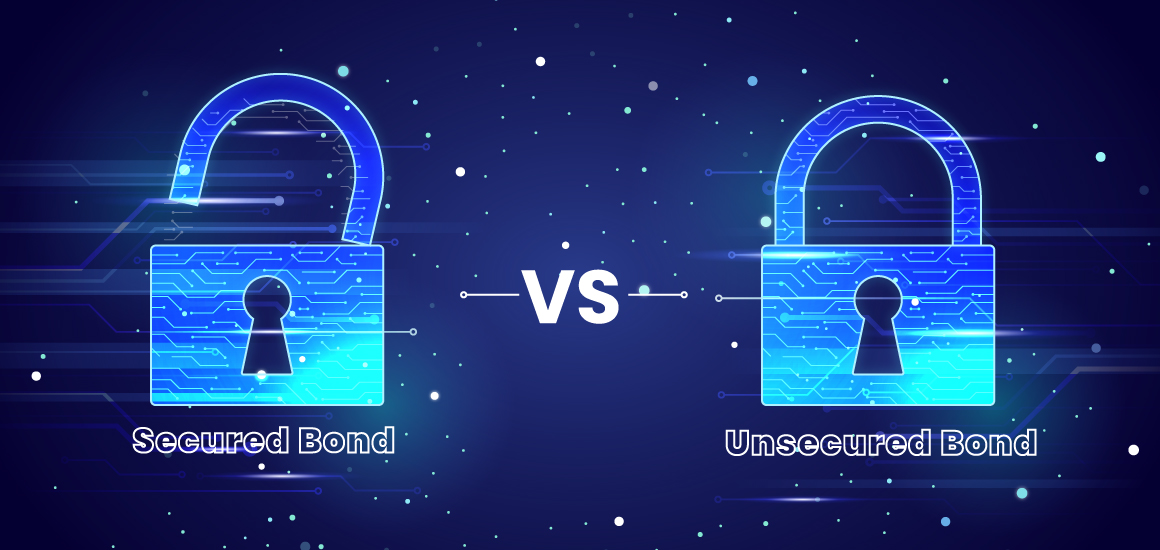Bonds, as a cornerstone of investment portfolios, come in various forms, each with distinct attributes that cater to different investor preferences. Within the investment sector of bonds, a fundamental classification exists: Secured Bonds and Unsecured Bonds.
Secured Bonds: Shielded by Collateral
Secured bonds derive their name from the security they provide to investors. These bonds are intricately tied to tangible assets or collateral, which acts as a protective shield for bondholders.
In essence, if the issuer defaults on their payment obligations, the collateral can be liquidated to compensate bondholders. Collateral may manifest as real estate, machinery, or liquid stocks – assets that hold inherent value.
Consider a mortgage, a common example of a secured loan. Just as the bank can repossess a home if mortgage payments falter, secured bonds offer a similar concept. This collateral-backed structure inherently reduces risk for investors, making secured bonds an attractive option for risk-averse individuals.
Unsecured Bonds: Trusting in Good Faith
Unsecured bonds, often termed debentures, take a different approach. Unlike secured bonds with tangible collateral, unsecured bonds rest upon the “full faith and credit” of the issuer. While this instills a level of trust in the issuer’s commitment to repay, it lacks the direct claim to specific assets seen in secured bonds. Consequently, if the issuer faces insolvency, there is no designated asset pool for bondholders to tap into.
The absence of collateral renders unsecured bonds riskier than their secured counterparts. In scenarios where the issuer cannot meet payment obligations, bondholders may find themselves at a loss. To compensate for this heightened risk, unsecured bonds tend to offer investors higher interest rates, reflecting the additional return required to balance the uncertainty.
What do you mean by OBPP?
Comparing Key Features
The contrasting features of secured and unsecured bonds yield several critical distinctions that influence investment decisions:
Risk Profile and Safety: Secured bonds are often perceived as safer investments due to their asset-backed structure. In contrast, unsecured bonds are exposed to higher risk levels, given the lack of collateral.
Interest Rates: The lower risk associated with secured bonds translates to lower interest rates. Unsecured bonds, seeking to attract investors despite their riskier nature, offer comparatively higher yields.
Issuer Dynamics: Smaller businesses seeking investor confidence may opt for secured bonds, leveraging collateral to instill trust. Established enterprises, equipped with robust credit profiles, typically lean toward issuing unsecured bonds.
Investor Preferences: Conservative investors seeking stability may gravitate toward secured bonds, appreciating the added safety net. Conversely, those embracing risk for the prospect of higher returns might find unsecured bonds appealing.
Bankruptcy Implications: In the unfortunate event of bankruptcy, secured bondholders possess a greater likelihood of recovering their investment through collateral liquidation. Unsecured bondholders, lacking such collateral, may face challenges in recouping their investment.
An Instance of Secured Bonds: Mortgage-backed Securities
Imagine you are a real estate investor named Sarah. You decide to issue secured bonds to raise funds for a new property development project. In this case, the property you’re developing serves as collateral for the bonds. This means that if you encounter financial difficulties and are unable to make interest or principal payments to bondholders, they have a claim on the property.
Investors who purchase your secured bonds are essentially lending you money in exchange for regular interest payments. In the event that you’re unable to fulfill your payment obligations, bondholders have the right to take ownership of the property and sell it to recover their investment. This asset-backed security provides a level of safety for bondholders, as the underlying property value provides a cushion against potential losses.
An Instance of Unsecured Bonds: Corporate Debentures
Now consider you are a well-established technology company named Tech Innovate Inc. Seeking to expand your operations, you decide to issue unsecured bonds, also known as debentures. These bonds are not backed by specific collateral like property or assets; instead, they rely on your company’s overall financial health and creditworthiness
Investors who purchase your unsecured bonds trust that your company will make timely interest and principal payments. They invest based on your reputation, market standing, and future prospects. Unlike secured bonds, where specific assets provide security, debenture holders rely solely on your company’s ability to generate sufficient revenue and profit to meet its obligations.
If, unfortunately, your company faces financial difficulties and can’t make the required payments, bondholders lack a direct claim to specific assets. They become unsecured creditors in the event of bankruptcy, standing in line with other creditors to recover their investment.
Stocks might be eye catchy bonds are relaxing though
Comparing the Two Scenarios
In the secured bonds scenario, investors have a safety net in the form of collateral (the property) that they can fall back on if payments are not made. This reduces their risk exposure, and as a result, secured bonds typically offer lower interest rates to investors.
In the unsecured bonds scenario, the risk profile is higher, as investors rely solely on your company’s financial health and ability to generate revenue. To compensate for this increased risk, unsecured bonds usually come with higher interest rates, providing a potentially higher return to investors who are willing to accept a greater level of risk.
Ultimately, both secured and unsecured bonds have their advantages and trade-offs, and the choice between the two depends on various factors, including the issuer’s creditworthiness, investor risk tolerance, and investment objectives.
The Investment Landscape
The decision to invest in secured or unsecured bonds is multifaceted, hinging on individual financial objectives, risk tolerance, and investment horizon. Secured bonds offer reassurance through tangible collateral, making them suitable for risk-averse investors. On the other hand, unsecured bonds, despite their inherent risk, present an avenue for potentially higher returns, attracting those with a higher risk appetite.
Both secured and unsecured bonds hold their place in diversified investment portfolios. Recognizing their unique attributes equips investors to make decisions aligned with their financial goals. Ultimately, whether prioritizing safety or going with calculated risk, the choice between secured and unsecured bonds underscores the personalized nature of investment strategies.






